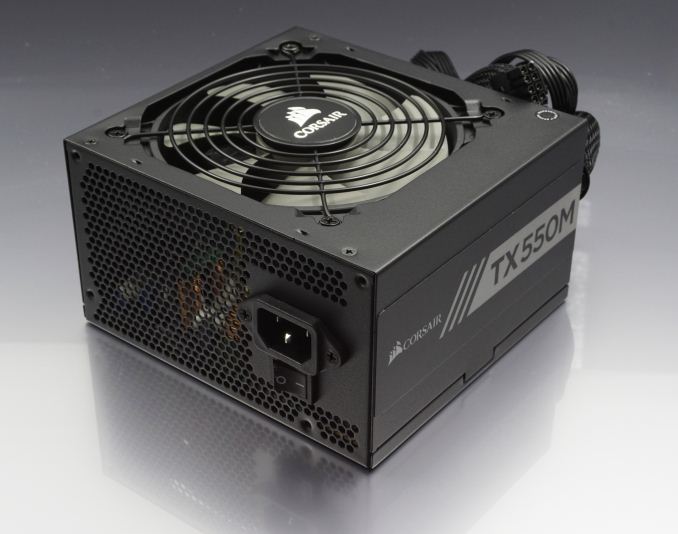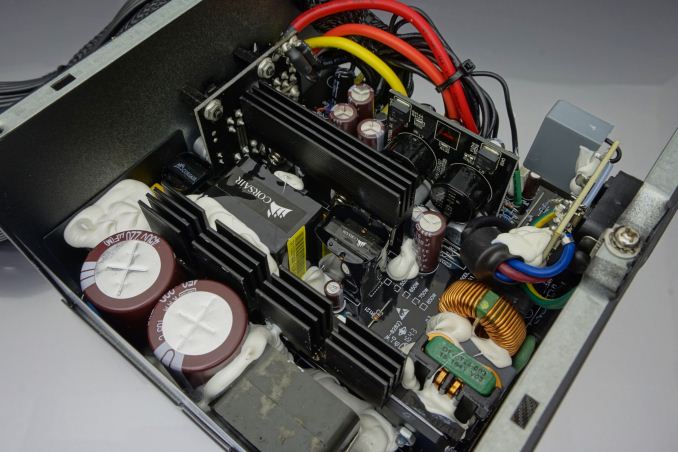The $80 Power Supply for Almost Everyone: The Corsair TX550M 80Plus Gold PSU Review
by E. Fylladitakis on December 1, 2017 8:00 AM EST- Posted in
- Cases/Cooling/PSUs
- Corsair
- PSUs
- 550W
- TX
- Modular
- Power Supply
Conclusion
With the TX-M series, Corsair is trying to fill the gap between its low-cost products and the high performance HX/AX series. The TX-M PSUs are designed to entice the average user who wants something better than a basic model, yet without having to break the bank in order to obtain it. Today we reviewed the least powerful model of the series, the TX550M. As its name implies, the TX550M has a maximum power output of 550W, which is more than adequate for typical single-GPU gaming/workstation systems. It is rated for continuous operation at 50°C and comes with an 80Plus Gold efficiency certification.
The Corsair TX550M is based on a platform by Great Wall, a Chinese OEM, which Corsair has been cooperating with for several of their PSUs over the past few years. This is the most advanced version of this platform that we have seen to this date, boosting the efficiency (just) enough for the PSU to earn an 80Plus Gold efficiency certification. Corsair’s optimizations did not stop there, as their engineers also managed to significantly improve the power quality of the PSU, resulting to low ripple/noise levels for a PSU of this class. The voltage regulation also is very good. Overall, the electrical performance of the TX550M is excellent for a “mainstream” PSU.
On the other hand, the thermal performance could use a few upgrades. The TX550M is neither too hot or too loud - just unsophisticated. Its thermal control feels archaic by today’s standards, when it could have a more powerful fan paired with a start/stop function, allowing it to operate fanless when possible but also keep the temperatures low when needed. The TX550M however is using the fan all the time, even when it does not really need to, making the PSU audible when it could be entirely quiet. On the other hand, the mediocre fan can barely provide enough airflow to maintain safe operating temperatures under adverse environmental conditions. Overall, the thermal control of the TX550M certainly works, but it could do much better.
Aesthetics are a subjective matter, but making the TX series aesthetically unique or attractive clearly was not Corsair’s focus. Unlike the more expensive PSUs of the company, the TX-M does not feature a custom chassis with chamfered edges and other aesthetic improvements. It is using a typical ATX steel chassis, with its only aesthetic improvements being a matte black paint and a semi-modular design. In terms of quality, Corsair is using components only from renowned manufacturers and we also found the assembly job of the TX550M to be excellent. It is no chance that the company is covering the latest TX-M units with a seven year warranty. The TX550M is a PSU designed to reliably serve for many years.
Summing up the above, the TX550M is a very reliable PSU with good electrical performance, making it an ideal choice for users who want to power a typical single GPU gaming/workstation system and have no need for extra/exotic features. Its current retail price of $80 is reasonable, yet it can be frequently found on sale for less than $70 (the 650W version is on sale for $74 at the time of this review), offering an outstanding value-to-performance ratio and long-term reliability.












42 Comments
View All Comments
Kitsunemimi - Friday, December 1, 2017 - link
>People need reliability, not 3D graphics.Yeah, because all this "gaming" nonsense and those GeForce video cards are so dumb and pointless.
>long list of things people don't need [...] because of media hype, like [...] smart phones
I agree that the reason why effectively the entire mobile phone market has converted to smart phones within the span of a mere few years is none other than "media hype".
>cell phones
Are you high?
>3D video cards are expensive and energy wasting.
>people don't need [...] hybrid cars
What a joke.
wolfemane - Friday, December 1, 2017 - link
I own a hybrid for the simple fact I only have to stop at a pump once a month vs once a week. I didn’t get one for environmental reasons, social status, or media hype. I got one because my family needs a car and I’m sick of paying for gas. And before you get all high and mighty again, it cost no more than a similar size car with a similar package.DanNeely - Friday, December 1, 2017 - link
I'm not quite breakeven with the payment on my Accord hybrid at current prices/commute length; but probably will be after I move next summer (planning on a better but more distant location). Even if current prices/miles driven stay the same I'll break even about 1.5 years after my car's paid off and net $400/year afterwards. I kept my previous car for just under 11 years before something not worth the cost of fixing failed and forced a replacement (I was hoping for 2-3 more years out of it); so I should come out ahead by a good margin over the lifetime.Yuriman - Friday, December 1, 2017 - link
I picked up a used Insight around 4 years ago for 3 grand. Averaging between 65 and 85mpg, put 75,000 more miles on it with nothing but a set of tires and some oil changes. According to records I got from the previous owner, it's still on its 17 year old factory hybrid battery. From a value perspective it's hard to beat. Even compared with an economy car like a Civic or Corolla, this car has paid for itself in gas alone.New hybrids often don't have much premium over their non-hybrid counterparts, and seem to have, on average, better reliability, so I don't think the original comment holds any weight.
MrSpadge - Friday, December 1, 2017 - link
And I always wondered who's buying those low end Quadros. Have fun saving money with them over the "expensive 3D cards". Oh, and never use iGPUs - they have the 3Ds as well!AntonErtl - Friday, December 1, 2017 - link
Actually my PC without discrete graphics card (MSI Z170A-Pro, Core i5-6600K @4GHz, 16GB RAM, 3 SSDs, DVD drive) idles at 22W, and the peak power consumption I see is around 70W (still below the 20% point of its 400W PSU); and I measured the current into the PSU, i.e., these numbers include the PSU losses. I have a discrete graphics card lying around (Radeon 6770); the game I play runs nicely with the iGPU, though, so I did not put it in the box. With this card, the power consumption would be still less than 200W.hybrid2d4x4 - Friday, December 1, 2017 - link
"The optimal power range for a typical home entertainment/gaming system usually is within 400-600 Watts"Please stop regurgitating this kind of nonsense. The optimal range is as low as 120W for integrated video systems and up to ~300W for top-tier single card. There's the 1% that will overclock and/or run multiple vid cards, and these are the only people that will ever stress this kind of PSU to even 50%.
As a point of reference, my i5 4670, GTX1060, 4x4GB DDR3, 1 SATA SSD + 1 HDD system idles at 40W, and uses a peak of 220W measured at the wall. Typical gaming is 170-200W. I'm using a 400W Platinum PSU, and feel like this is a bit overkill for this system.
For a workstation with IGP, I would want a gold/plat 200W PSU, but nothing like this exists thanks to these articles normalizing the 500W-800W PSUs for normal consumers. Please stop it!
fred666 - Friday, December 1, 2017 - link
I agree.There is no reason to get more than 300-400W for the average user and this is including a stand alone video card and lots of peripherals. It's sad to see web sites such as Anandtech fall into the marketing BS of the power supplies makers.
t.s - Sunday, December 3, 2017 - link
average user using PC around 100-200Wsonny73n - Saturday, December 2, 2017 - link
I also agree.I fell for articles like this one and ended up with a 850W Corsair PSU. Even tho I OCed my i5 and my GPU, the power peak would never go above 380W.
Fool me twice, shame on me... Well, almost.